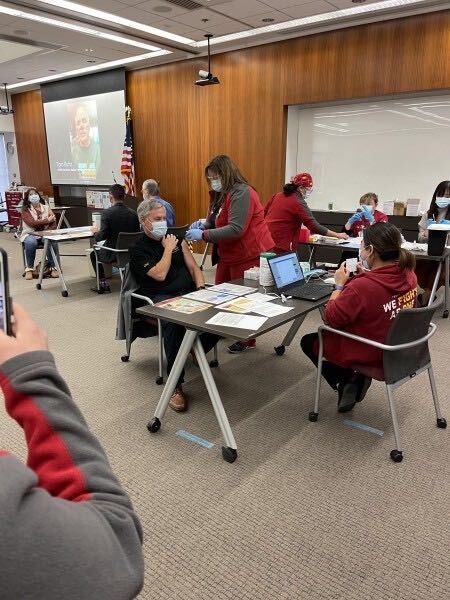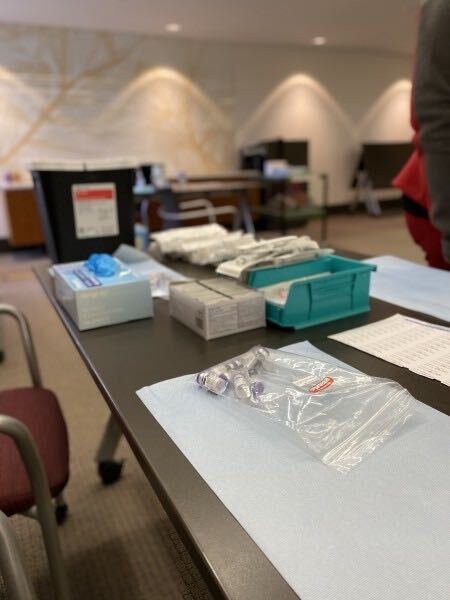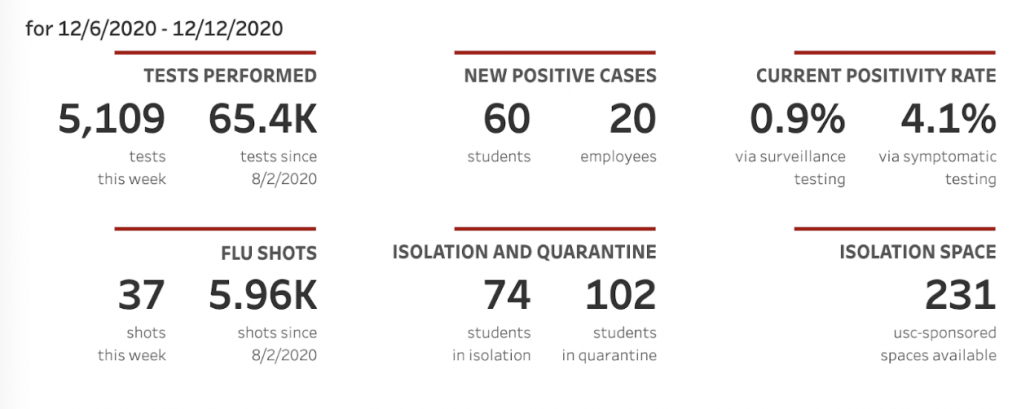First 2,500 doses of Pfizer/BioNTech vaccine arrive at Keck Medical Center, USC Verdugo Hills Hospital

Armand Dorian, MD, chief medical officer, can barely hide his enthusiasm at being vaccinated. 
Keith Hobbs, CEO, hopes getting a vaccine himself helps staff feel comfortable doing the same. 
Staff created an assembly line to efficiently vaccinate 475 health care workers over the next few days. 
Edward Jones-Lopez, MD, infectious diseases; Peter Marshall, MD, pulmonary critical care; Noel Battle, MD, family medicine; Sara Troyer, patient care technician; Samuel Ware, RN; Dodgie Cortes, nursing supervisor; Addie Morgan, department of public safety; and Maria Saravia, environmental services, are the first to receive the vaccine at Keck Medicine of USC.
A total of 2,500 doses of the Pfizer/BioNTech coronavirus vaccine arrived at Keck Medical Center and USC Verdugo Hills Hospital Thursday, Chief Health Officer Dr. Sarah Van Orman said in a student media briefing the same day. Health care workers, including USC Student Health staffers, were the first to get vaccinated.
Los Angeles County-USC Medical Center is one of three hospitals in Los Angeles County that will begin mass vaccination efforts Friday, alongside Olive View-UCLA Medical Center and Harbor-UCLA Medical Center, L.A. County Health Services announced in a press release Thursday. These efforts plan to administer 6,000 vaccinations by Christmas.
“Part of what we’re doing right now with a vaccine is we really want to start building excitement about it, educating people, getting people ready,” Van Orman said. “But also, unfortunately, we’re in this really challenging position where we’re at the worst we’ve ever been over the next four to six weeks, and … we’re not going to have enough supplies of vaccine to get people vaccinated to prevent the serious situation we’re in right now.”
According to the University’s COVID-19 in Numbers dashboard, 60 students and 20 employees tested positive for the coronavirus in the week of Dec. 6-12. Van Orman said most of the cases have still been attributed to travel and small gatherings during the Thanksgiving holiday, aligning with public health numbers across the city and county.

“Everything we thought might be happening with Thanksgiving and what was happening in Los Angeles happened at USC, that the surge that we’re seeing in L.A. County is really being repeated in our students, faculty and staff,” Van Orman said. “There’s a lot of COVID-19 infections right now, the level of community prevalence and transmission is extremely high.”
While asymptomatic positivity rates via external testing distributor Color’s surveillance testing remained at 0.9% last week, Van Orman said that the past few days have seen about a 1.2% asymptomatic positivity rate. Additionally, symptomatic positivity rates increased to 4.1% last week, a jump from 3.0% positivity during the week of Nov. 29 to Dec. 5, according to the dashboard.
“[The 1.2% positivity] still seems like a low number, but for reference in October, it was a 0.05% … so we’ve had almost over a 20-fold increase,” Van Orman said. “So I think that to me is a really telling, telling number. Again, many people who test positive, they don’t know where they got it, but they may have gone to a gathering or an event or something like that.”
The arrival of the Pfizer/BioNTech vaccine doses follows record-breaking days for coronavirus cases and deaths, both across L.A. County and nationwide. KTLA reported that one in 80 people in the county have COVID-19, public health officials announced at a press briefing Wednesday. Officials also recorded 138 new deaths — the most ever recorded in the County since the pandemic began — and 22,422 new coronavirus cases, with a backlog of about 7,000 late test results.
On average, two people in L.A. County are dying from the virus every hour, according to KTLA. Additionally, the availability of intensive care unit beds throughout Southern California reached critical mass with 0% open Thursday, the Los Angeles Times reported.
According to Van Orman, USC has aligned its vaccine distribution program with statewide guidance. ABC News reported that Gov. Gavin Newsom announced that Phase 1A of the program includes health care workers and residents and staff of nursing and long-term care facilities, which he said includes about 3 million people statewide. Along with health care workers who are on the frontlines, Van Orman said students who are working in the health professions such as medicine and dentistry are also included in the first group for vaccine distribution at USC.
Phase 1B will comprise about 8 million essential workers, though guidelines for distinguishing essential workers and for prioritizing vaccinations among these workers have yet to be finalized, ABC News reported. At USC, Van Orman said this group will consist of employees who are working on campus, such as workers in USC Housing, USC Facilities and Management Services and USC Environmental Health and Safety.
Van Orman said Student Health is preparing for more batches of doses to arrive in January that can potentially be administered to lower priority groups. She said it is more than likely that students will begin to get vaccinated during the spring semester.
“There’s a lot of questions about how soon and how quickly the vaccine will become available for those groups outside of these very first,” Van Orman said. “We really just have our first batch of doses right now.”
Van Orman said in a student media briefing Dec. 10 that there are roughly four main groups for USC’s vaccine distribution program. Following the first group of health care workers and essential, on-campus workers, Van Orman said the second group includes those who work in education settings and/or are at higher risk, including immunocompromised students. Most students will fall under the third group, and the fourth group will involve everyone else, she said.
According to Van Orman, senior administrators at USC such as President Carol Folt and Vice President for Student Affairs Winston Crisp will also be vaccinated in adherence to statewide guidelines. The order in which administrators can get vaccinated depends on the nature of their positions at USC, how that affects the degree to which they can get exposed to the coronavirus and where they themselves fall on the vaccine priority list, Van Orman said.
“I’ve told people that we want everybody to be in their right group and be the first person in line when their group comes up, so some of it depends on what their job is, are they working on-site, do they have contact with the public?” Van Orman said. “Senior administration would need to do that, kind of think about what their job is, where they fall in that priority list, and then be vaccinated.”
For example, since Van Orman is a health care worker and sees patients, she said that she will be in one of the earlier groups to get vaccinated; however, Student Health staffers who are working in testing tents are given higher priority than physicians like herself because they are more exposed to the virus.
According to Van Orman, while the Pfizer/BioNTech vaccine has demonstrated considerable efficacy, meaning that those vaccinated are getting protected from the coronavirus as a result, there is still much unknown about whether being vaccinated prevents transmission of the virus. Van Orman said she hopes that more data will be made available to fill in these gaps of knowledge.
Looking forward, Van Orman said the coronavirus vaccine will likely be a requirement for students in order to attend in-person classes at USC, though Student Health will also provide an option for personal declination.
“We want everybody to sort of acknowledge they know the vaccine’s available, they understand the risks they might be taking by choosing not to be vaccinated,” Van Orman said. “That’s a personal risk, and also then letting us know that they are actively declining the vaccine, but we would not sort of require it in the sense of you have to have it to come back.”
This article was updated Dec. 17 at 7:26 p.m. to reflect the start of vaccination efforts at Keck Medical Center and USC Verdugo Hills Hospital the same afternoon.

